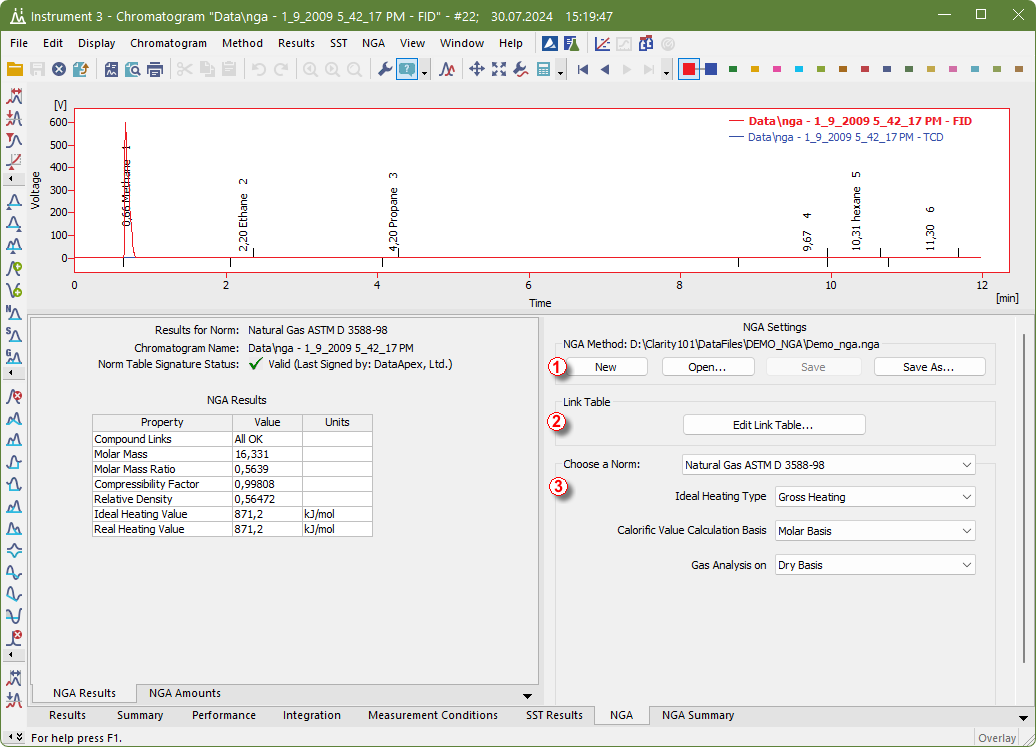NGA Settings
In this pane, you can set up the NGA Method - choose a norm and edit its parameters.

Chromatogram window - NGA Results - NGA Settings
Displays the currently opened NGA Method. All settings in the NGA Method are saved in a *.nga file, which is independent on the method opened from the Instrument window.
New
Creates a new NGA Method with default settings.
Open
Displays the Open NGA Method dialog where you can select NGA method you want to use.
Save
Saves the settings of the current NGA Method.
Save As…
Opens the Save NGA Method As dialog for saving the NGA Method into a new file.
Link Table ②
The Compound Names for the NGA Results are retrieved from the Calibration Summary Table. In calibrations, it is possible to use multi-signal chromatograms. However, it is necessary to set the detection of each compound to one signal only, otherwise you will see warnings in the NGA Results pane (this can be specified by the Used checkbox; the selected signal can be switched using Calibration - Set Signal).
Compounds with the same names in calibrations as in the norms are automatically included in NGA calculations. If the compound names in norms differ from the names set in the calibration, you can use the Link Table for linking those compound names to ensure that all compounds are included in the calculations. For more details see also chapter Link Table
Opens the Link Table dialog, where you can create and edit links between compound names in calibrations and norms.
Select the norm you want to use for your calculations. Each norm has a specific list of parameters that can be changed:
- ISO 6976-16
- ISO 6976-95
- ASTM D 3588-98 and GPA 2172-19
- LPG ASTM D 2598-02 / 2421-02
- LPG ISO 8973-97 / EN 589+A1
Determines that the Amount is in mole fractions (only option supported by ISO 6976-16).
Calorific Value Calculation Basis
Determines the units in which to calculate the Gross and Net Calorific Values.
Selects the combustion temperature.
Selects the metering temperature.
Determines whether the calculations are for Ideal or Real Gas. For the Real Gas, the Compression Factor is added to the results.
Only calculations on dry gas basis are supported by ISO 6976-16 (effects introduced by water are considered in calculations only if the water content is determined in the chromatogram).
Specifies the metering pressure (the valid range is between 90 and 110 kPa).
Determines whether the Amount is in mole fractions or in volume fractions. Volume fractions are converted to mole fractions if selected.
Calorific Value Calculation Basis
Determines the units in which to calculate the Superior and Inferior Calorific Values.
Selects the combustion and metering temperatures.
Determines whether the calculations are for Ideal or Real Gas. For the Real Gas, the Compression Factor is added to the results.
Determines whether to include a mole fraction of water or not. If water is included in calculations, it is also added to the NGA Amounts.
Ideal Heating Type
Determines whether to calculate Gross Heating Value or Net Heating Value. For gross calculations, the water condenses to liquid, and, for net calculations, the water remains in the vapor state.
Calorific Value Calculation Basis
Determines the units in which to calculate the Heating Value.
Determines whether to include a mole fraction of water or not. If water is included in calculations, it is also added to the NGA Amounts (but not for GPA 2172-19).
Original Basis
Determines the source Amount type. It can be Liquid, Mole, Gas, or Weight type. Other types are converted to Liquid type.
Determines the source Amount type. Both Molar and Mass fractions are required for calculations (one is converted into another). If Volume fractions are selected, only the Octane Number can be calculated.
The approximate temperature of liquid.